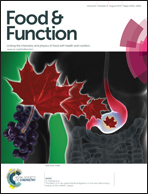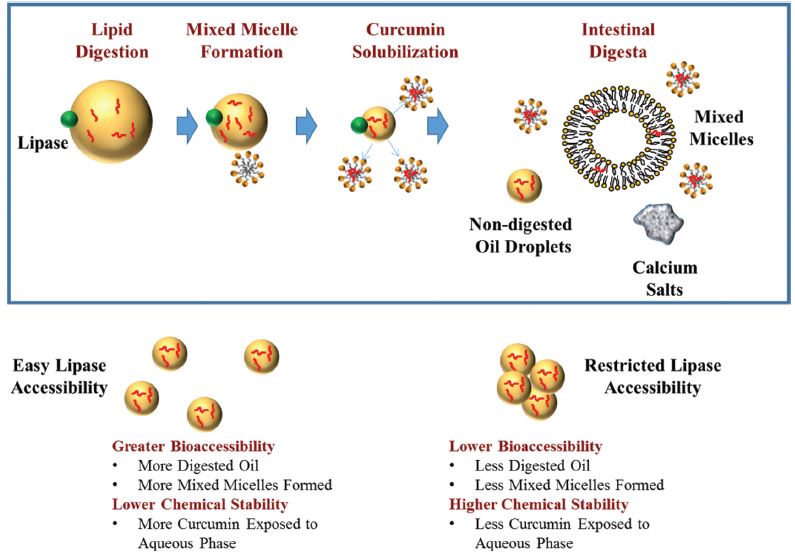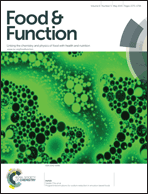
Want to know more? Read the full article below – its free to access for the next 6 weeks!
Keep up-to-date with the latest content in Food & Function by registering for our free table of contents alerts.

Want to know more? Read the full article below – its free to access for the next 6 weeks!
Keep up-to-date with the latest content in Food & Function by registering for our free table of contents alerts.
Written by Tom Wilson for Chemistry World

Ever wondered exactly why sugar takes the bitter edge off your morning coffee? A recent theoretical study into caffeinated drinks has dispelled a long-held hypothesis; besides directly masking the flavour of caffeine, additives were found to influence our taste perception via a direct caffeine–additive interaction, rather than affecting the water structure around the caffeine molecules.
Read the full article in Chemistry World >>>
Caffeine dimerization: effects of sugar, salts, and water structure
Seishi Shimizu
Food Funct., 2015, Advance Article
DOI: 10.1039/C5FO00610D, Paper
Do you fancy submitting an article to Food & Function? Why not submit to us here today or alternatively email us with your suggestions!
 Let it be Indian, Afghani, Cambodian, Vietnamese, Nepalese or Thai cuisine, Turmeric (Curcuma longa) is an integral part of all of them and many more! Turmeric is widely used in food preparations as a spice, pigment, and nutraceutical because of its characteristic flavour profile, yellow colour, and biological activity. Turmeric is not only an essential ingredient in food but also a very important component of many formulations in medicine owing to the potential health benefits it offers. Have you ever wondered what gives turmeric the power to do so?
Let it be Indian, Afghani, Cambodian, Vietnamese, Nepalese or Thai cuisine, Turmeric (Curcuma longa) is an integral part of all of them and many more! Turmeric is widely used in food preparations as a spice, pigment, and nutraceutical because of its characteristic flavour profile, yellow colour, and biological activity. Turmeric is not only an essential ingredient in food but also a very important component of many formulations in medicine owing to the potential health benefits it offers. Have you ever wondered what gives turmeric the power to do so?
Curcumin is one of the most biologically active components within turmeric. The potential health benefits and good safety profile of curcumin makes it an essential ingredient in functional food products as a nutraceutical ingredient. However, the high melting point and poor water solubility of curcumin make it difficult to incorporate into many functional foods and beverages, and its poor stability in vivo and low bioaccessibility within the gastrointestinal tract reduce its biological activity. The strategy that is widely used to address these shortcomings is to encapsulate it within food-grade delivery systems such as nanoparticles, hydrogel beads, emulsions and suspensions which help in shielding curcumin on its way towards the target resulting in improving its functional performance.
Can there be an alternate strategy?
In their search for the answer to this question, Wei Liu et al. form Nanchang University and David McClements et al. from UMass, Amherst have devised a strategy to develop excipient foods that are consumed with curcumin-rich foods. Oil-in-water emulsions turned out to be better candidates for developing excipient foods. The study involved the influence of emulsifier type on the ability of excipient emulsions to solubilize curcumin, and to increase its bioaccessibility. In their recent article in Food & Function, they have discussed the rational design of excipient emulsions by varying the emulsifier type as well as the preparation conditions of emulsions, and the effect of these emulsions on the fate of curcumin in simulated gastrointestinal digestion.
A schematic presentation of fate of curcumin under different emulsifying conditions is shown in the figure below.

The results of this study substantiate the utility of excipient foods in improving functional performance of curcumin which can be extended to other lipophilic nutraceuticals and vitamins. To read the complete story and to know how the yellow colour helped them to determine the bioaccessibility of curcumin, read the full paper for free* using the link below:

The 7th International Conference on Polyphenols and Health (ICPH7) will be hosted by the Vinci congress centre in Tours, France between 27th-30th October 2015
‘ICPH is the most important international forum to present and discuss the latest trends, topics and developments in the field of polyphenols, food science and health.’
Main topics of discussion:
Dates for your diary:
The conference will feature talks from many leading researchers in the field including, John van Duynhoven (Wageningen University, The Netherlands), Rosa Maria Lamuela-Raventos (University of Barcelona, Spain) and Hang Xiao (University of Massachusetts, USA)
Click here for the full programme >>>
To find out more about the conference and to register your interest, please visit their website www.icph2015.com
From April – June 2015, our most downloaded Food & Function articles were:
Digestive diversity and kinetic intrigue among heated and unheated β-lactoglobulin species
Simon M. Loveday, Malleswara R. Peram, Harjinder Singh, Aiqian Ye and Geoffrey B. Jameson
Food Funct., 2014, 5, 2783-2791
DOI: 10.1039/C4FO00362D, Paper
A standardised static in vitro digestion method suitable for food – an international consensus
M. Minekus, M. Alminger, P. Alvito, S. Ballance, T. Bohn, C. Bourlieu, F. Carrière, R. Boutrou, M. Corredig, D. Dupont, C. Dufour, L. Egger, M. Golding, S. Karakaya, B. Kirkhus, S. Le Feunteun, U. Lesmes, A. Macierzanka, A. Mackie, S. Marze, D. J. McClements, O. Ménard, I. Recio, C. N. Santos, R. P. Singh, G. E. Vegarud, M. S. J. Wickham, W. Weitschies and A. Brodkorb
Food Funct., 2014, 5, 1113-1124
DOI: 10.1039/C3FO60702J, Paper
Nuts, especially walnuts, have both antioxidant quantity and efficacy and exhibit significant potential health benefits
Joe A. Vinson and Yuxing Cai
Food Funct., 2012, 3, 134-140
DOI: 10.1039/C2FO10152A, Paper
Microencapsulation of bioactives for food applications
Maria Inês Dias, Isabel C. F. R. Ferreira and Maria Filomena Barreiro
Food Funct., 2015, 6, 1035-1052
DOI: 10.1039/C4FO01175A, Review Article
Anti-inflammatory activity of natural dietary flavonoids
Min-Hsiung Pan, Ching-Shu Lai and Chi-Tang Ho
Food Funct., 2010, 1, 15-31
DOI: 10.1039/C0FO00103A, Review Article
Transcription profiles of LPS-stimulated THP-1 monocytes and macrophages: a tool to study inflammation modulating effects of food-derived compounds
Wasaporn Chanput, Jurriaan Mes, Robert A. M. Vreeburg, Huub F. J. Savelkoul and Harry J. Wichers
Food Funct., 2010, 1, 254-261
DOI: 10.1039/C0FO00113A, Paper
Coffee: biochemistry and potential impact on health
Iziar A. Ludwig, Michael N. Clifford, Michael E. J. Lean, Hiroshi Ashihara and Alan Crozier
Food Funct., 2014, 5, 1695-1717
DOI: 10.1039/C4FO00042K, Review Article
Potential bioavailability enhancement of bioactive compounds using food-grade engineered nanomaterials: a review of the existing evidence
Kathleen Oehlke, Marta Adamiuk, Diana Behsnilian, Volker Gräf, Esther Mayer-Miebach, Elke Walz and Ralf Greiner
Food Funct., 2014, 5, 1341-1359
DOI: 10.1039/C3FO60067J, Review Article
Review of in vitro digestion models for rapid screening of emulsion-based systems
David Julian McClements and Yan Li
Food Funct., 2010, 1, 32-59
DOI: 10.1039/C0FO00111B
Variations in caffeine and chlorogenic acid contents of coffees: what are we drinking?
Iziar A. Ludwig, Pedro Mena, Luca Calani, Concepción Cid, Daniele Del Rio, Michael E. J. Lean and Alan Crozier
Food Funct., 2014, 5, 1718-1726
DOI: 10.1039/C4FO00290C, Paper
Interesting read? Let us know your thoughts below.
And remember, you can submit direct to Food & Function here
The front cover of issue 7 features artwork by Lars P. Christensen from the University of Souther Denmark. Along with his colleagues, Lars ivestigates how alcarinol and falcarindiol may represent scaffolds for novel partial PPARγ agonists with possible antidiabetic properties.
Interested to know more? Read the full article below – its free to access for the next 6 weeks!
Polyacetylenes from carrots (Daucus carota) improve glucose uptake in vitro in adipocytes and myotubes
Rime B. El-Houri, Dorota Kotowska, Kathrine B. Christensen, Sumangala Bhattacharya, Niels Oksbjerg, Gerhard Wolber, Karsten Kristiansen and Lars P. Christensen
Food Funct., 2015, 6, 2135-2144
DOI: 10.1039/C5FO00223K
Keep up-to-date with the latest content in Food & Function by registering for our free table of contents alerts.
 We are pleased to announce that the latest Impact Factor* for Food & Function is 2.8, according to the 2014 Journal Citation Reports ®.
We are pleased to announce that the latest Impact Factor* for Food & Function is 2.8, according to the 2014 Journal Citation Reports ®.
We would like to thank all of our authors, referees, Editorial Board and Advisory Board for their contributions to the success of the Journal.
*The Impact Factor provides an indication of the average number of citations per paper. Produced annually, Impact Factors are calculated by dividing the number of citations in a year by the number of citeable articles published in the preceding two years.
The front cover of issue 6 features artwork by C. de Loubens et al. from Institut de Recherche sur les Phénomènes Hors Equilibre, France. Along with his colleagues Loubens developed a three-dimensional lattice-Boltzmann model to gain insight into the effects of villous movements and the rheology of digesta on flow, mixing and absorption of nutrients at the periphery of the intestinal lumen.
Interested to find out more? Read the full article below – its free to access for the next 6 weeks!
Flow and mixing by small intestine villi
Y. F. Lim, C. de Loubens, R. J. Love, R. G. Lentle and P. W. M. Janssen
Food Funct., 2015, 6, 1787-1795
DOI: 10.1039/C5FO00285K
Keep up-to-date with the latest content in Food & Function by registering for our free table of contents alerts.
The front cover of issue 5 features artwork by Natalie Chiu from The University of Nottingham. Along with her colleagues, Natalie investigates a microstructure approach to reduce sodium levels in emulsion based foods. If successful, this strategy will enable reduction of sodium without affecting consumer satisfaction with regard to salty taste.
Have a read of the full article below – its free to access for the next six weeks:
Programmed emulsions for sodium reduction in emulsion based foods
Natalie Chiu, Louise Hewson, Ian Fisk and Bettina Wolf
Food Funct., 2015, 6, 1428-1434
DOI: 10.1039/C5FO00079C
Keep up-to-date with the latest content in Food & Function by registering for our free table of contents alerts.
3rd International Conference 2015

The 3rd International Conference for Food Structures, Digestion and Health will be hosted by InterContinental Wellington between 28th October – 30th October 2015.
The 2015 Food Structures, Digestion and Health international conference presents a new opportunity to bring together food industry professionals, and world leading scientists from diverse disciplines with a common interest in food design that delivers better nutrition and improves consumer wellbeing.
Topics for discussion:
Dates for your diary:
Call for abstracts open: 27 March 2015
Registration open: 27 March 2015
Deadline for receipt of Abstracts: 21 August 2015
Notification of acceptance of Abstracts: 31 August 2015
Early registration closes: 18 September 2015
Conference: 28-30 October 2015
Final date for Publications: Strict deadline of 30 November 2015
The conference will feature talks from many leading researchers in the field, including Peter Lillford (University of Birmingham, UK), Paul Singh (University of California, USA) and Marie-Agnès Peyron (INRA, France)
Click here for the full progreamme >>>
To find out more about the conference and to register your interest, please visit their website http://www.fsdh2015.org/home